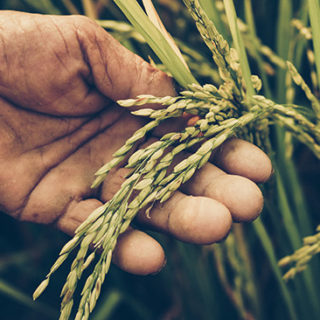Birds reveal climate change
Can we already see the effects of a warmer climate? By studying changes in the presence of various plants and animals, we can get signals about what is happening in our environment.
In her book Silent Spring, Rachel Carson wrote about her fears that birdsong would be silenced when birds could no longer find enough food due to the use of insecticides in agriculture. This marked the starting point for a continuous monitoring of the changes within various animal groups – to enable us to react before they disappear completely.
Birds have proven to be an excellent group to study in order to detect various changes in the environment, such as climate change. There are many species in many different environments, they are easy to count, and we can all relate to birds.
‟The Swedish bird community reacts very noticeably as a whole to climate change – the signals are crystal clear”, says ornithological researcher Åke Lindström.
Åke Lindström and his colleagues are studying how annual variations in the presence of birds in Sweden correlate to other factors such as temperature. These studies are based on the findings from Svensk Fågeltaxering (the Swedish bird count), for which Åke Lindström is responsible on behalf of the Swedish Environmental Protection Agency. Almost 600 volunteer birdwatchers take part in the bird count to monitor the bird population around the country. These inventories recur annually, summer and winter, in hundreds of locations around Sweden and have done so for over 40 years.
‟Our main task in the Swedish bird count is to produce population trends for just over 200 of our 250 bird species, i.e. to establish whether individual bird species populations are growing or shrinking”, explains Åke Lindström. ‟Over the past few years, we have also spent more time conducting more in-depth analyses.”
To analyse the extent to which the bird population has been affected by rising temperatures in recent decades, Åke Lindström takes the Species Temperature Index (STI) as a starting point. The STI reports temperature values by area for each bird species within Europe. Bird species which are described as ‟warm” are the ones that breed in warm regions, while ‟cold” species breed in cold regions. These values can in turn be used to calculate the average temperature of a local bird community (Community Temperature Index, CTI).
Are the bird communities’ average temperatures in various locations in Sweden becoming warmer or colder over time, and how does this relate to climate change?
‟We conduct 800–900 bird inventories every summer in the same locations in Sweden. This enables us to monitor how the average temperatures of the bird communities change in various locations over time. These calculations clearly show that the Swedish bird communities have become ‟warmer” over the past 40 years. In addition, this change in CTI corresponds to changes in temperature. We observe that, in the regions where the temperature has risen most, i.e. in northern Sweden, the CTI has also seen its biggest increase.
Bird inventories are also carried out in winter. Analyses based on these calculations and the STI of the various species (based on their wintering region) show the same pattern as in the summer. Where the winter temperatures have risen, the ‟warm” species have also increased.
Currently, the researchers cannot definitively single out any individual species as winners or losers as a result of rising temperatures. But Åke Lindström observes that things are not going well for mountain birds.
‟This could be an effect of the climate. In that case, over the long term, the mountain birds would be the great losers – who risk a drastic drop in their numbers. After all, there are no colder places to fly to further north, beyond the Svalbard islands!”
Åke Lindström also sees three species which have increased considerably over the summers – the common chiffchaff, the Eurasian blackcap and the European goldfinch – and he believes this could be a result of rising summer temperatures. But the researchers cannot say with certainty what causes these bird species to increase in number.
‟We don’t know whether they manage to produce more offspring per breeding season or whether there is a rise in survival rates from one year to the next, or both. It could also be due to individuals moving northwards in the country.”
The change in the CTI of the bird community as a whole thus proves that climate change is already having an impact on Swedish wildlife. Similar changes seem to be happening in other areas and for other species. This means that the presence, number and extension of other animals and plants are probably also affected by the climate. And when the entire ecosystem is disrupted, it is difficult to predict the consequences.
‟What we know about nature is that it is in constant change; we can never get back what was, but we can perhaps affect how things turn out in the future”, says Åke Lindström. ‟We are starting to get an idea of which species are sensitive and which are perhaps less so. This means that if we want to try and do something, we can direct resources where they are most needed – or where there may be the best chance of positively affecting the outcome.”
Text: Pia Romare
Facts
-
Community Temperature Index (CTI)
-
For each bird species, temperature values within Europe have been measured by area (Species Temperature Index, STI) for breeding grounds (summer temperatures) and wintering areas (winter temperatures). Those that only breed in Spain, for example, get a relatively high average summer value (the so-called ‟warm” species) whereas those that only breed in northern Sweden get a low value (‟cold” species).
For each bird species that breeds in Sweden, there is thus an average summer value and, similarly, an average winter value for each species that spends the winters there. Using all the species’ average values in a bird inventory, it is possible to calculate a common average temperature for the birds that have been counted on a given day. This becomes a measure of the bird community’s average temperature (Community Temperature Index, CTI) at that particular point in time.
If the bird inventories are repeated year after year, in the same location and at the same time of year, it is possible to see how the CTI changes over time and to compare it with changes in temperature.
-
Other factors affect birds more
-
There are other factors that affect the number of birds more than the climate, such as agriculture and forestry.
Things are going fairly well for forest birds as several species among them are increasing in number. Åke Lindström participated in another study showing that the most likely explanation for this population growth is a combination of the increase in wooded areas and improved forest structure, such as more dead wood and more deciduous trees, along with rising temperatures.
It is mainly the birds in the agricultural landscape that have seen their numbers drop in Sweden. This can be ascribed to various factors, such as the 20 per cent reduction in agricultural land over the past 50 years, the landscape being less varied, the loss of small biotopes for nesting and finding food, the rising use of fertiliser by farmers and the transition from spring sowing to autumn sowing.
-
Rachel Carson’s book Silent spring
-
Rachel Carson’s book Silent spring (1962) was a wake-up call which set off the environmental movement in the western world. The title alludes to the disappearance of birdsong – a sign that growing numbers of animals were dying from the increasingly widespread use of environmental toxins (especially DDT) in agriculture.







